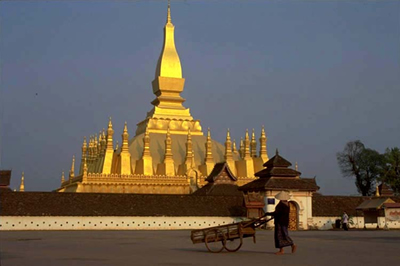
The capital of Laos is booming. Driven by rising foreign investment, plenty of foreign aid workers and a more urbane youth, change is coming as quickly as in any city in Asia. However, even with all this dynamism you won’t see words like ‘hustle’ and ‘bustle’ being used to describe Vientiane, which can still mount a strong argument for being the most relaxed capital city on earth.Vientiane means ‘Sandalwood City’, and is actually pronounced Viang Chan (Viang means ‘city’ or ‘place with walls’ in Lao; Chan means sandalwood); the French are responsible for the modern transliteration. The combination of tree-lined boulevards and dozens of temples impart an atmosphere of timelessness, while the kaleidoscopic architectural styles reflect it’s historic influences, from classic Lao through Thai, Chinese, French, US and Soviet.
As Laos continues to open itself to the world, Vientiane is where the struggle between a communist past and inevitably more capitalist future is most dramatically played out. Lao bands sing lyrics censored by the government to dancing youths who’d look at home in any Western bar. The Lao National Museum still has displays glorifying the victory over capitalist foreign imperialists, but across the road another slick restaurant opens in what is becoming one of the best-value dining cities on earth. The contrasts are fascinating.
Of course, Vientiane is not only about witnessing change. The 6400 Buddhas at Wat Si Saket, the religious art of Haw Pha Kaeo, and the lotus-inspired lines of Laos’s gilded national symbol, Pha That Luang, speak of the historical importance of the city. Patuxai and the surreal Xieng Khuan (Buddha Park) may have less artistic merit, but like the city itself, they’re not short of appeal.
Climate
Laos has a tropical monsoon climate, with a pronounced rainy season from May through October, a cool dry season from November through February, and a hot dry season in March and April. Generally, monsoons occur at the same time across the country, although that time may vary significantly from one year to the next. Rainfall also varies regionally, with the highest amounts– 3,700 millimeters annually–recorded on the Bolovens Plateau in Champasak Province. City rainfall stations have recorded that Savannakhét averages 1,440 millimeters of rain annually; Vientiane receives about 1,700 millimeters, and Louangphrabang (Luang Prabang) receives about 1,360 millimeters. Rainfall is not always adequate for rice cultivation, however, and the relatively high average precipitation conceals years where rainfall may be only half or less of the norm, causing significant declines in rice yields. Such droughts often are regional, leaving production in other parts of the country unaffected. Temperatures range from highs around 40°C along the Mekong in March and April to lows of 5°C or less in the uplands of Xiangkhoang and Phôngsali in January.





